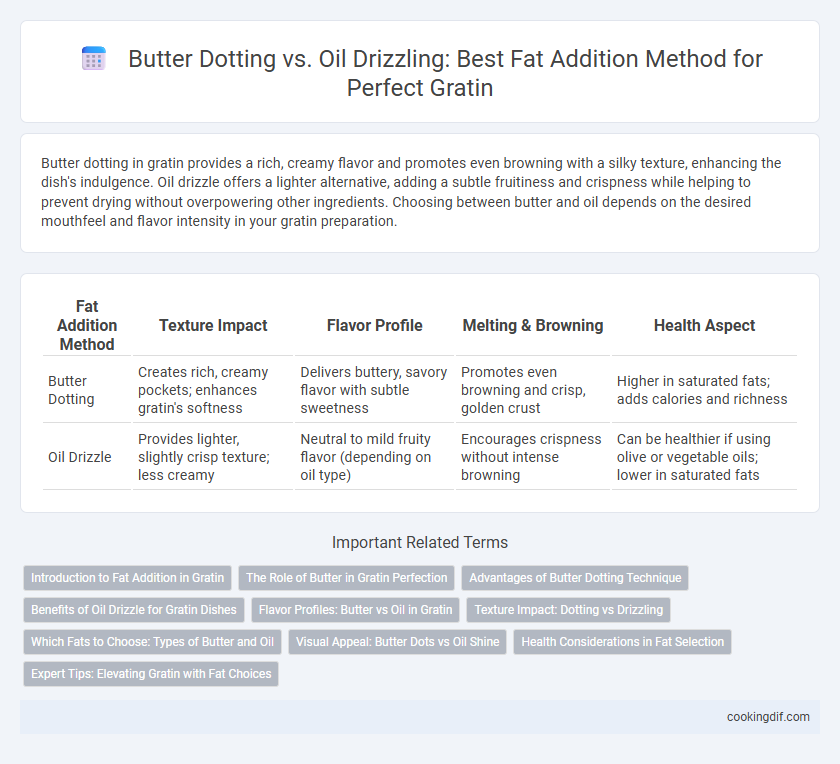Butter dotting in gratin provides a rich, creamy flavor and promotes even browning with a silky texture, enhancing the dish's indulgence. Oil drizzle offers a lighter alternative, adding a subtle fruitiness and crispness while helping to prevent drying without overpowering other ingredients. Choosing between butter and oil depends on the desired mouthfeel and flavor intensity in your gratin preparation.
Table of Comparison
| Fat Addition Method | Texture Impact | Flavor Profile | Melting & Browning | Health Aspect |
|---|---|---|---|---|
| Butter Dotting | Creates rich, creamy pockets; enhances gratin's softness | Delivers buttery, savory flavor with subtle sweetness | Promotes even browning and crisp, golden crust | Higher in saturated fats; adds calories and richness |
| Oil Drizzle | Provides lighter, slightly crisp texture; less creamy | Neutral to mild fruity flavor (depending on oil type) | Encourages crispness without intense browning | Can be healthier if using olive or vegetable oils; lower in saturated fats |
Introduction to Fat Addition in Gratin
Butter dotting in gratin enhances richness and promotes even browning due to its milk solids, creating a creamy texture and golden crust. In contrast, oil drizzle, often olive oil, adds a lighter finish with a slightly fruity flavor and reduces risk of burning at high temperatures. Selecting the appropriate fat influences moisture retention and flavor development critical for the gratin's signature texture and taste.
The Role of Butter in Gratin Perfection
Butter plays a crucial role in achieving gratin perfection by providing rich flavor, moisture, and a golden, crisp crust through its milk solids and fat content. Dotting butter evenly over the surface ensures gradual melting and browning, enhancing texture and taste more effectively than an oil drizzle. The unique composition of butter contributes to the classic gratin's creamy interior and irresistibly crunchy top layer, making it the preferred fat for this dish.
Advantages of Butter Dotting Technique
Butter dotting in gratin preparation enhances flavor complexity by distributing rich, creamy fat evenly across the surface, promoting superior browning and a golden crust. This technique offers precise control over fat placement, ensuring consistent melting and moisture retention, which oil drizzle may not achieve as effectively. The natural milk solids in butter contribute to a deeper, more savory taste profile and an appealing texture that elevates the overall dish quality.
Benefits of Oil Drizzle for Gratin Dishes
Drizzling oil over gratin dishes enhances texture by creating a crispier, golden crust compared to butter dotting, which can sometimes result in uneven melting. Oils like olive oil contribute beneficial monounsaturated fats and a subtle fruity flavor that complements the rich ingredients without overwhelming them. Using oil also improves heat distribution, promoting even browning and reducing the risk of burning often associated with concentrated butter spots.
Flavor Profiles: Butter vs Oil in Gratin
Butter dotting in gratin enhances richness and imparts a creamy, slightly nutty flavor from the caramelization during baking, creating a luscious mouthfeel. In contrast, an oil drizzle, especially using olive oil, introduces a fruity and sometimes peppery note that complements the dish with a lighter, more pronounced aromatic profile. Choosing butter or oil affects the gratin's overall taste complexity and texture, with butter offering indulgent depth and oil providing a fresh, vibrant finish.
Texture Impact: Dotting vs Drizzling
Butter dotting in gratins creates distinct pockets of richness that melt and brown unevenly, enhancing a creamy, layered texture with a slightly crisp top. Drizzling oil evenly coats the surface, promoting uniform browning and a consistently crispy crust without localized melting. The choice between butter dotting and oil drizzling directly influences the gratin's textural complexity and mouthfeel.
Which Fats to Choose: Types of Butter and Oil
Choosing the right fat for gratin significantly influences texture and flavor; European-style butter with higher fat content offers a rich, creamy taste while dotting provides even melting without excess pooling. Olive oil, especially extra virgin varieties, contributes a fruity, robust flavor and a healthier monounsaturated fat profile, ideal for a lighter drizzle that enhances crispness. Clarified butter, with its higher smoke point, excels in dotting when aiming for browning without burning, whereas lighter oils like grapeseed or avocado oil serve well for subtle fat addition and a neutral taste.
Visual Appeal: Butter Dots vs Oil Shine
Butter dotting creates small, creamy pools that melt into golden brown spots, enhancing the gratin's textured surface with a rustic and inviting appearance. Oil drizzle forms a glossy, uniform shine that amplifies the dish's overall luster, giving it a sleek, polished finish. Visual appeal in gratin preparation depends on whether a rich, dotted contrast or an even, luminous coating is desired.
Health Considerations in Fat Selection
Choosing between butter dotting and oil drizzle for gratin fat addition impacts health factors such as saturated fat content and calorie density. Butter contains higher levels of saturated fat, which may raise LDL cholesterol and contribute to cardiovascular risks, whereas oils like olive or avocado offer healthier monounsaturated fats that support heart health. Opting for oil drizzle can enhance nutrient absorption and reduce saturated fat intake, aligning with dietary guidelines for reducing cardiovascular disease risk.
Expert Tips: Elevating Gratin with Fat Choices
Butter dotting infuses gratin with rich, creamy flavor and promotes a golden, crispy crust through even melting and browning. Oil drizzle offers a lighter fat option that enhances moisture retention and delivers a subtly nutty aroma, ideal for crisp, delicate textures. Experts recommend combining both fats strategically to balance decadence and crunch, optimizing gratin's texture and flavor complexity.
Butter dotting vs Oil drizzle for fat addition Infographic

 cookingdif.com
cookingdif.com